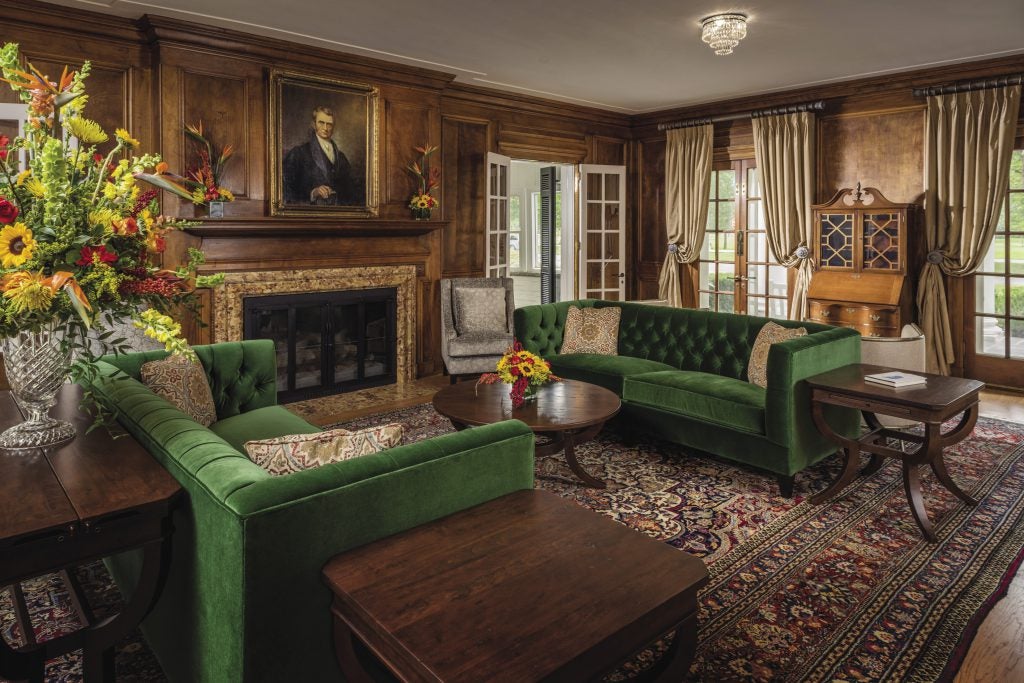A collaborative effort sees the President’s House receive a much-needed renovation.
It was 1978 when Dale Osburn took an apprenticeship job in Marshall University’s Physical Plant carpentry shop.
He was a 17-year-old student in the university’s cooperative education program, and he remembers well his first job in the big, white house at 1040 13th Ave., where Marshall University President Robert Hayes lived with his family.
“I remember walking in there the first time and being scared to death, thinking, ‘Don’t break anything,’” recalled Osburn, now the director of the Marshall Physical Plant. “I worked on a pair of doors that wouldn’t close, and Mrs. Hayes baked me cookies.”
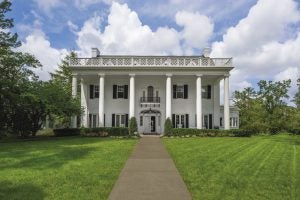 It was the first of many jobs he would have in that house, a striking, Greek Revival-style home built in 1923. Osburn’s biggest undertaking with the house came over the past year, when he shepherded a renovation project to help update the historic home across from Ritter Park to accommodate the latest technology and make it look as beautiful as it did for its first owner, the former Huntington Mayor William Campbell.
It was the first of many jobs he would have in that house, a striking, Greek Revival-style home built in 1923. Osburn’s biggest undertaking with the house came over the past year, when he shepherded a renovation project to help update the historic home across from Ritter Park to accommodate the latest technology and make it look as beautiful as it did for its first owner, the former Huntington Mayor William Campbell.
With the help of dozens of contractors, Marshall University renovated the 5,956-square-foot home, which has been under the university’s ownership since 1971. During the 1970s, a lot of work was done on the house to change its look to the aesthetics of that time period. But a team of professional designers, painters, electricians, plumbers, tile workers and many other craftsmen worked tirelessly throughout 2015 and early 2016 to return it to its 1920s splendor while making it state-of-the-art.
“It’s now a modern house with the old face to it,” Osburn said. “The house has its own personality, and to see it go from a 1970s type look to its original look in the 1920s — there’s nothing like it. It’s been a lot of work. I’ve lost a lot of sleep over that house. We went more than the extra mile.”
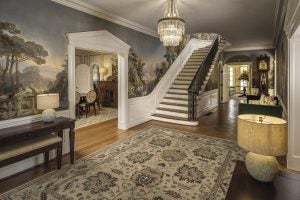 Some of the jobs undertaken were replacing the gas, water and the sewage system, along with completing much-needed electrical updates and reworking the HVAC. The kitchen and bathrooms were remodeled. A second-floor hobby room was transformed into a walk-in closet.
Some of the jobs undertaken were replacing the gas, water and the sewage system, along with completing much-needed electrical updates and reworking the HVAC. The kitchen and bathrooms were remodeled. A second-floor hobby room was transformed into a walk-in closet.
The downstairs was beautified with new cabinetry, furniture and light fixtures. The house also has new carpeting and refinished flooring. Some of the original wallpaper was restored while other walls got new paint and refurbished trim.
Outside the home, the landscaping got a fresh look and the garage underwent a transformation as well, being redesigned to accommodate newer vehicles rather than Model T-sized cars. Workers poured new concrete, cleaned and restored the slate on the front porch, did tuckpointing on the brickwork and much more.
It was a project months in the making. The plans were laid as the university began its search for a new president after the unexpected death of President Stephen J. Kopp. It had been many years since the house got the full attention it needed.
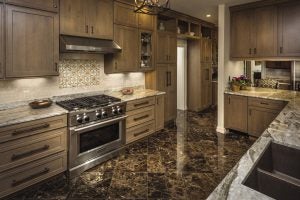 “It was to a point where we really had to make repairs,” Osburn said. The roof and plumbing needed work, as did the heating and electrical systems. Also, the decor was quite dated.
“It was to a point where we really had to make repairs,” Osburn said. The roof and plumbing needed work, as did the heating and electrical systems. Also, the decor was quite dated.
The timing seemed to be appropriate to address everything all at once, Osburn said, adding that there were too many truly exceptional contractors who lent their talents to the project to name them all. The general contractor on the project was MIRC Construction.
As for Marshall employees who offered a great deal of help, they included Tony Crislip, Ronnie Hicks, Bill Black, Glen Adkins, Chris Albright, Tom Jessup, Eric Wallace, Mike Farley, Ken Holley, Danny Holland, Paul Glover, John Bailey, Dorothy Rinehardt and others.
On the designs, Phoebe Randolph of Edward Tucker Architects Inc. worked closely with Osburn and Marshall’s Brandi Jacobs-Jones, Ginny Painter and Interim President Gary White, along with Susan Pierce, the deputy state historic preservation officer. The goal was to maintain historic value to meet standards of the National Register of Historic Places, which was a challenge while trying to make necessary upgrades, even when altering the garage.
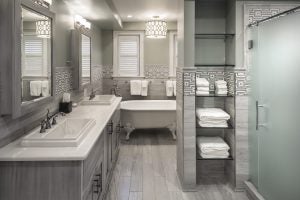 Overall, however, it was a fun project, Randolph said — especially because it offered a chance to travel back to the 1920s. She incorporated art deco and art nouveau themes while planning the house’s new look.
Overall, however, it was a fun project, Randolph said — especially because it offered a chance to travel back to the 1920s. She incorporated art deco and art nouveau themes while planning the house’s new look.
“We designed the renovation to keep with the original character of the house, and used 1920s influences for the design,” Randolph said. “We used geometric patterns, colors and fabrics from that time. … We didn’t know who the president was going to be, so we felt the house was our client. What we did was fitting for the character of the house.
“We’re thrilled to have the chance to help out and honored to participate. It’s been wonderful to work with the Marshall staff and their facilities people.”
MacKenzie-Dow Fine Furniture of Huntington provided a dining room table, a buffet, and some chairs and sofas in the house, along with lighting and artwork downstairs. The company has a showroom inside Marshall’s Visual Arts Center downtown and was eager to be part of such a historic project for the university, said owner Gary Adams.
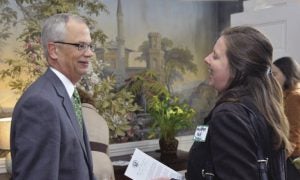 “To be in the president’s house is one of those jobs in Huntington you’d love to be part of,” he said. “We’re honored to have been asked.”
“To be in the president’s house is one of those jobs in Huntington you’d love to be part of,” he said. “We’re honored to have been asked.”
Another local company that worked diligently on the house was Chandler’s Kitchens. Salesman Paul Spaulding, who has worked at Chandler’s for more than 50 years, spent countless hours focusing on kitchen and bath measurements for new cabinetry and appliances. There were frequent changes along the way, and sometimes he’d have to go out to the house three or four times a day. But it was well worth it seeing the gorgeous outcome, particularly the master bath and kitchen, he said.
“I’ve done a lot of kitchens, and this is one of the prettiest I’ve ever done,” he said. “I’m very proud of it. I went to Marshall and am a big sports fan and am proud to have had a part in it.”
For Osburn, renovating the house “hasn’t been an 8 to 4 job,” he said. “It’s been a big adventure, and I wouldn’t have it any other way.
“When you’re a 17-year-old kid coming to work at Marshall through the cooperative education program, you kind of have a heart for the house,” he said.
“This project has been a solid year of my life, but I’ve enjoyed it. I probably know that house better than I know my own. … Certain things you do in your life, you never forget. This is one of those things for me.”
Jean Hardiman is a Uniontown, Ohio, native who moved to Huntington 17 years ago to work at The Herald-Dispatch. She is a freelance writer, and is married with two young daughters and a grown stepdaughter.
Photos: (From second from top) The Marshall president’s house, built in 1923, stands proudly at 1040 13th Ave. across from Ritter Park in Huntington. Because they didn’t know who the new president was going to be, Phoebe Randolph of Edward Tucker Architects Inc. said those working on the house treated it as their client and stayed true to its 1920s roots. The kitchen is one of the rooms that received the most extensive renovations, including new cabinets and appliances for a stunning finish. The décor for the master bathroom was inspired by Art Deco and Art Nouveau themes and features an elegant clawfoot tub. President Gilbert speaks with Dr. Mary Katherine Gould, professor of dietetics, at an open house for faculty and staff. The first floor of the house is available for university events.
